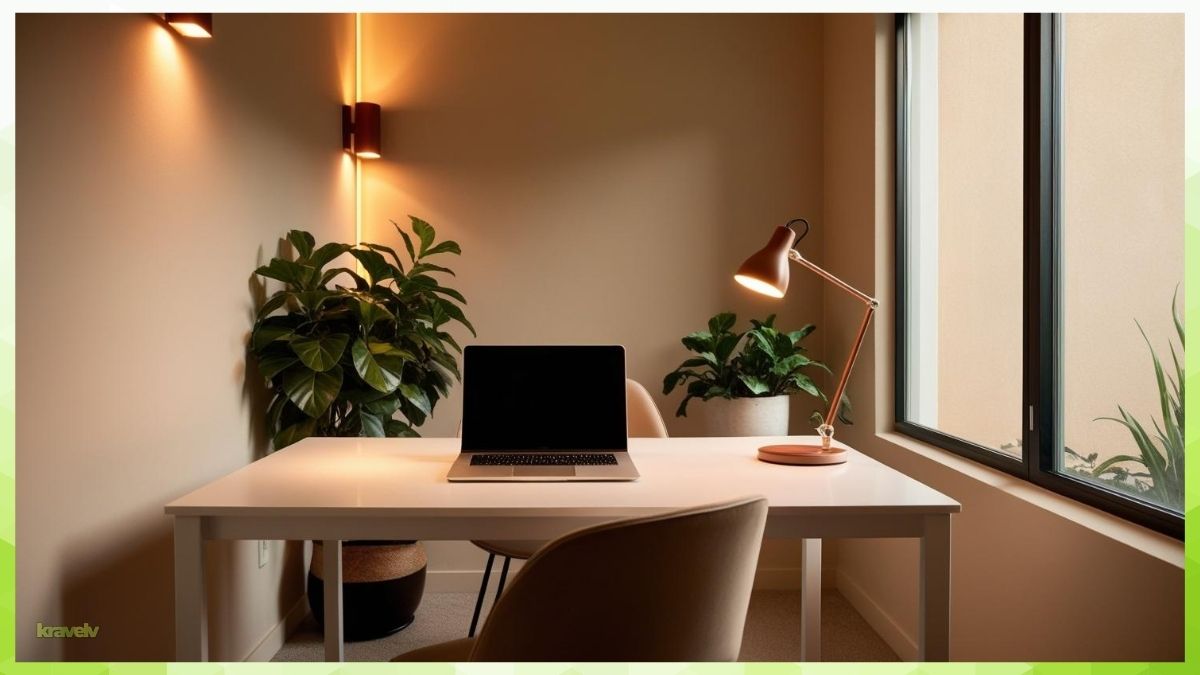Last Updated on April 11, 2025 by Kravelv Spiegel
Lighting in your home office might seem like a small detail—but it’s secretly running the show. From your energy levels to how sharp your brain feels at 3 PM, light has an undeniable impact on how you work, feel, and even sleep. Ready to master your setup?
💡Key takeaways:
- Light affects your mood, focus, and circadian rhythm, making it crucial for productivity.
- Natural light is the best source for boosting alertness and mental clarity, so maximizing daylight in your workspace matters.
- Artificial lighting, when chosen and placed correctly, can reduce eye strain and maintain energy throughout the day.
- Lighting should be customized to your work style and daily rhythm, using layering, smart lighting, and regular adjustments.
Why Lighting Matters in Your Home Office
We tend to overlook it, but lighting might just be your best coworker—or your worst enemy. The light in your home office can either boost your energy or make you feel like curling up for a nap. Let’s break down why it’s such a big deal.
The Science Behind Light and Brain Function
Ever wonder why you feel more alive on a sunny day? That’s serotonin and melatonin doing their thing. Bright light increases serotonin, which makes you happier and more alert. Dim or poor lighting can throw off your circadian rhythm, leaving you tired and unfocused.
Mood vs. Focus – How Light Influences Both
Mood lighting isn’t just for romantic dinners. A well-lit space can literally brighten your mood. At the same time, the right lighting temperature and intensity can help your brain concentrate better, especially during mentally heavy tasks.
Natural Light – Your Secret Productivity Weapon
Let’s not overcomplicate things—sunlight is free and powerful.
How to Maximize Daylight in Your Workspace
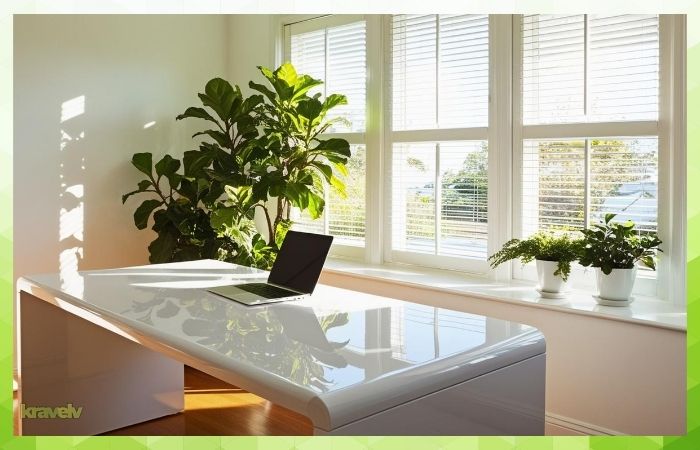
Place your desk near a window. Open blinds during the day. Use mirrors or glossy surfaces to bounce light around. Even a small amount of daylight exposure can help you feel more awake.
Best Window Placement for Office Desks

Ideally, your desk should face perpendicular to the window. That way, light hits from the side—reducing screen glare and shadows on your work.
Artificial Light Done Right
When the sun goes down—or your office doesn’t get much light—you need a good backup.
Choose the Right Light Bulbs

Not all bulbs are created equal, so here’s what to look for:
Color Temperature – Warm vs. Cool
- Warm light (2700K–3000K): Cozy, but not great for focus
- Cool light (4000K–5000K): Crisp, ideal for working hours
- Daylight (5000K+): Great for detailed tasks
Lumens – Not All Brightness Is Equal
Lumens measure brightness. For focused tasks, go for at least 450 lumens in desk lamps and 800+ for overhead lighting.
Avoiding Eye Strain with Task Lighting
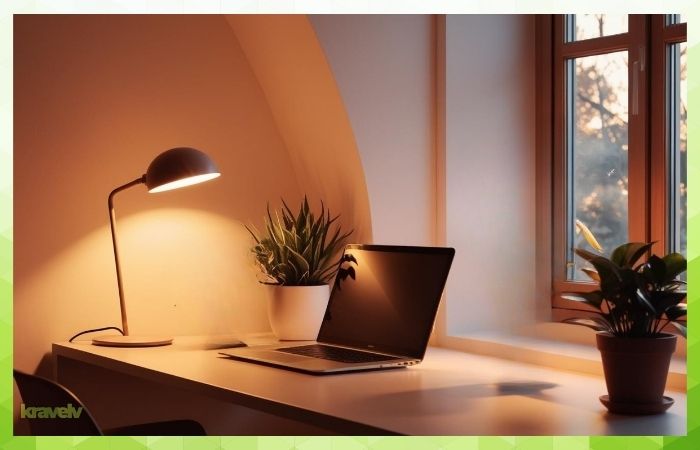
Use adjustable desk lamps to shine directly on papers or your keyboard—reducing squinting and slouching.
Let’s build your perfect lighting setup:
Overhead Lighting
This is your base layer. Use flush mounts, ceiling fans with lights, or pendant lights. Avoid overly bright ones—soft and diffused is better.
Desk Lamps
This is where you focus. Look for ones with adjustable necks and brightness control.
Ambient and Accent Lighting
Think floor lamps, wall sconces, or even fairy lights. They make the space feel warm and inviting without being distracting.
Common Lighting Mistakes to Avoid
Even the most stylish home office can suffer if the lighting isn’t right. Here are some of the most common slip-ups people make—and how to fix them fast:
1. Relying Solely on Overhead Lights
A single overhead light can leave parts of your workspace in shadow and create eye strain over time. Instead, layer your lighting—combine overhead lights with task lighting and ambient sources like floor lamps or wall sconces. This creates a balanced, even spread of light across the room.
2. Using Harsh White or Blue Lights All Day
Cool white or blue-toned lights may feel energizing at first but can become overwhelming over hours of use, especially in the evening. Too much exposure to blue light late in the day can also disrupt your sleep. Use cooler light in the morning and early afternoon, then switch to warmer tones later in the day.
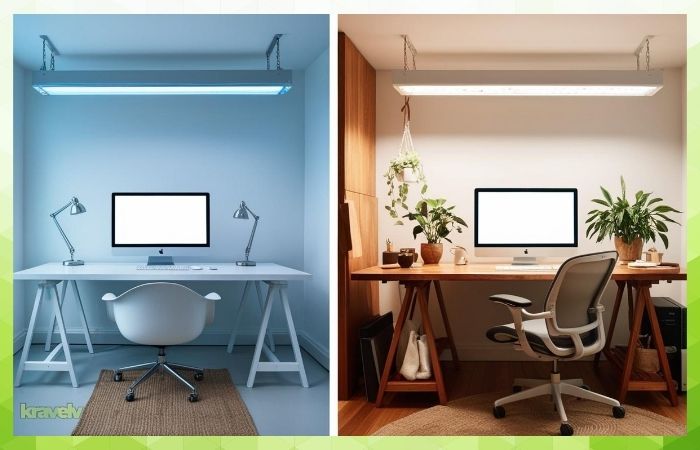
3. Ignoring Screen Glare and Shadows
Bad light placement can cause glare on your screen or cast annoying shadows over your keyboard or workspace. Make sure your light source is not directly behind you (which causes screen glare) or directly above your monitor (which creates shadow zones). Side lighting is usually best.
4. Overlooking Dimmable or Adjustable Fixtures
Lighting needs change depending on the task, time of day, and mood. Without adjustable lighting, you’re stuck with one setting—often too bright or too dim. Opt for dimmable bulbs or fixtures to give yourself flexibility.
5. Cluttering the Space with Too Many Small Lights
While it’s great to have layered lighting, using too many small, uncoordinated light sources can create visual clutter and uneven brightness. Aim for a few well-placed, multi-functional lights instead of many scattered ones.
Mood-Boosting Lighting Hacks
Want to feel better instantly? Try this:
Add Dimmer Switches
Instant control over your light’s intensity. Great for transitioning from work to relax mode.
Use Smart Lighting Systems
Apps or voice assistants let you adjust your lights with a tap or command. Super convenient and fun to use.
The Role of Light Placement
It’s not just what kind of light you use—it’s where you put it.
Eliminate Shadows and Glare
Position lights so they don’t shine directly into your eyes or reflect off your screen. A little testing goes a long way.
Positioning Lights for Zoom Calls
Avoid backlighting (like windows behind you). Place a light in front of you—like a ring light or desk lamp—for a polished look.
How to Light a Small Home Office
Tight on space? No worries.
Multi-Use Lighting Tricks
Use wall-mounted lights to save desk space. Try clamp lamps or under-shelf LED strips.
Vertical Lighting Ideas for Tiny Rooms
Tall floor lamps or sconces pull the eye upward, making the room feel bigger and brighter.
Creative Lighting Ideas That Spark Joy
Who said work lighting has to be boring?
Add LED Light Strips
Under shelves, behind monitors, or along walls—these bring a modern, cozy glow.
Try Color-Changing Smart Bulbs
Set the mood with a tap—calm blue for writing, energizing yellow for calls, or deep orange for wind-down time.
Biophilic Lighting – A Natural Touch
Nature vibes meet tech.
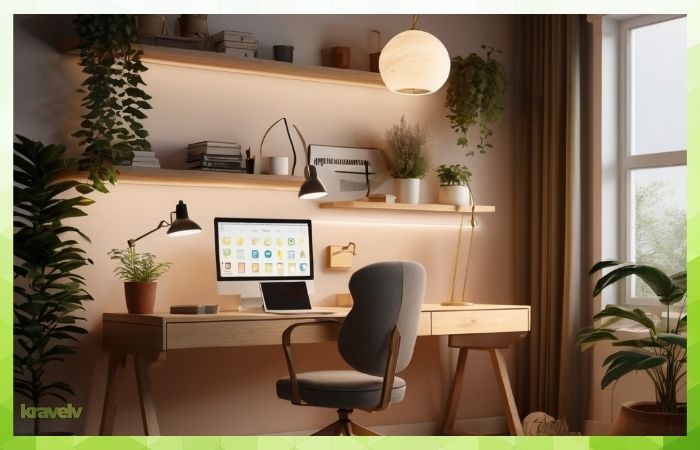
Combine Greenery and Light
Use grow lights for indoor plants. Bonus: They add oxygen and charm to your space.
Circadian Rhythm-Friendly Options
Look into bulbs that adjust color temperature throughout the day to match your body’s natural clock.
Lighting on a Budget
Great lighting doesn’t have to mean a big price tag. With a little creativity and some smart choices, you can light your home office beautifully without overspending.
1. DIY Hacks Using What You Already Have
- Repurpose Lamps from other rooms. A bedside table lamp can double as a stylish desk light.
- Use mirrors to reflect existing light and make your space feel brighter.
- Rearrange your furniture to maximize natural light—putting your desk near a window can make a huge difference without costing a dime.
- Decorate with light-colored objects (white walls, glossy surfaces, light wood) to help bounce light around the room.
2. Affordable Tools That Make a Big Impact
- LED Bulbs: Inexpensive, energy-efficient, and long-lasting. Look for multipacks online or in discount stores.
- Smart Bulbs Under $15: Some brands offer app-controlled lighting that lets you change brightness and color temperature affordably.
- Clamp Lamps or Clip Lights: Space-saving and cost-effective, perfect for tight setups.
- String Lights or Fairy Lights: Add a cozy glow without breaking the bank. Great as accent lighting alongside a brighter task lamp.
3. Where to Shop on a Budget
- IKEA: Stylish and functional lighting solutions for less.
- Amazon Basics: Budget-friendly smart bulbs and desk lamps.
- Thrift Stores or Facebook Marketplace: Gently used lamps, light fixtures, or vintage finds at a fraction of the price.
- Dollar Stores: Occasionally have great deals on desk lamps, battery-operated lights, or even small LED strips.
4. Think Multi-Purpose
Buy lighting that does more than one thing:
- Under-shelf lighting strips can be used for both work lighting and decorative ambiance.
- A lamp with USB ports can charge your phone and light your desk.
- Wall-mounted sconces save space and add ambient light without needing table space.
Home Office Lighting Routine
Set your lighting to work with your body.
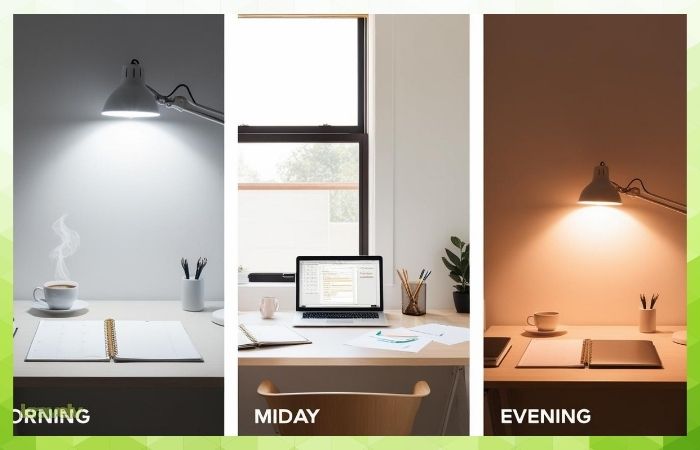
Morning, Midday, and Evening Adjustments
- Morning: Bright, cool white
- Midday: Slightly softer
- Evening: Warm, dimmed glow
Syncing Light With Your Workflow
Bright light for deep work. Soft light for brainstorming. Darkness (with a candle maybe?) for winding down.
Lighting for Different Work Styles
Different brains need different vibes.
For Creative Workers
Go for ambient lighting, warm colors, and dimmable lights that let your imagination roam.
For Focused, Analytical Tasks
You want clarity. Bright, cool lighting and task lamps keep you in the zone.
Test and Tweak – Find What Works for You
Lighting isn’t one-size-fits-all.
Keep a Lighting Journal
Try different setups and jot down how you feel. You’ll notice patterns quickly.
Adjust Seasonally
Winter may need brighter artificial lighting. Summer? Dim it down and soak up that natural sun.
Home Office Lighting FAQs
What’s the best lighting temperature for productivity?
A: Stick to cool white (around 4000K–5000K) for daytime work. It helps keep your brain alert and focused.
How do I reduce glare on my screen from lighting?
A: Use side lighting instead of placing lights directly in front or behind your screen. Matte screen protectors can help too.
Can I use string lights in my home office?
A: Absolutely! They add a cozy vibe and make your workspace more enjoyable—just make sure they’re not your only light source.
What’s the cheapest way to improve lighting fast?
A: Open the curtains, reposition a lamp, and swap in a brighter, cooler bulb. Total cost? Probably under $10.
Is it okay to work only with natural light?
A: Yes, but have backup lighting for cloudy days and evenings. Natural light is ideal, but you’ll need flexibility.
Final Words
Your lighting setup might seem like a small thing, but it’s a game-changer. With the right lighting, your mood improves, your focus sharpens, and your workspace feels like you. Start small—move your lamp, change a bulb, open your blinds—and notice how big the impact is. Light up your life, literally.

